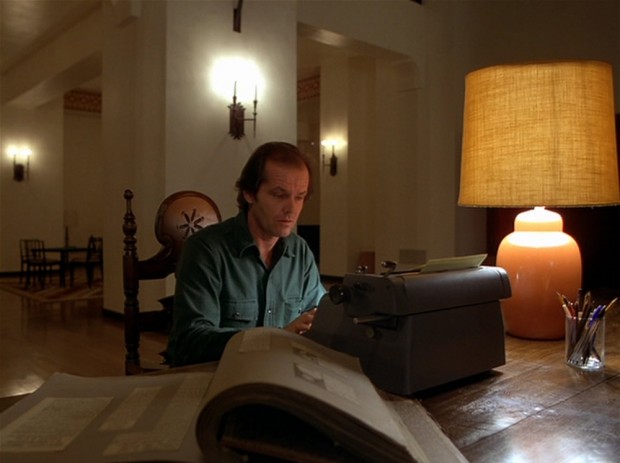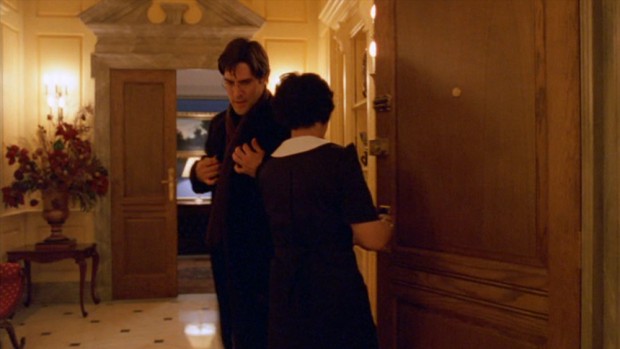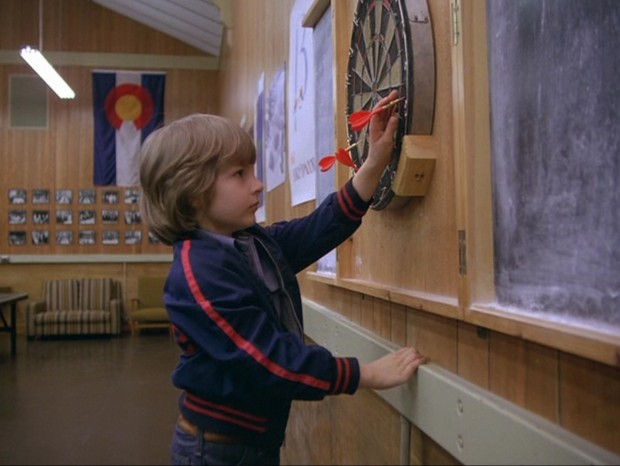STANLEY KUBRICK'S THE SHINING

Go to TOC for this film ( (which has also a statement on purpose and manner of analysis and a disclaimer as to caveat emptor and my knowing anything authoritatively, which I do not, but I do try to not know earnestly, with some discretion, and considerable thought).
TUESDAY
Forget Room 237, what about the open door to room 236
TOC and Supplemental Posts | Part 1 - The First Ascent | Part 2 - The Interview | Part 3 - Closing Day |
Part 4 - A Month Later | Part 5 - Tuesday | Part 6 - Thursday | Part 7 - Saturday | Part 8 - Monday |
Part 9 - Wednesday Part One | Part 10 - Wednesday Part Two | Part 11 - 8 AM | Part 12 - 4 PM |
Films Home
LINKS TO SECTIONS OF THE ANALYSIS ON THIS PAGE:
The Tuesday News, 182 through 184
Wendy slicing the mountaintop. The Carson City avalanche. Wendy's apron. News of the disappearance of Susan Robertson and the coming blizzard.
Danny Tries the Door of Room 237, Shots 185 through 191
Danny's circuit of the floor above the Colorado Lounge. The unobserved open door opposite Room 237. The ghost doorknob. Danny's third shining of the girls. The false illusions of the lodge blend with the artificiality of the movie set.
Jack Works, Shots 192 through 208
Many changes in the Colorado lounge. Some comparisons with A Clockwork Orange. The new rule.
The Fibonacci Sequence in Bartok's "Music for Strings, Percussion and Celeste, and its Relationship to the Maze
Jack's Attitude at His Typewriter as Wendy Exits
How Wendy's Opening the Can, and the Disappearance of the Chair and Table are Related and Commented upon by Kubrick in Jack's Notebook
In Review, What Has Kubrick Given Us in This Section?
What's the teaser candy bait?
What's the distraction?
What's the deep infrastructure?
THE TUESDAY NEWS
WENDY SLICING THE MOUNTAINTOP AND THE CARSON CITY AVALANCHE - WENDY'S APRON - NEWS OF THE DISAPPEARANCE OF SUSAN ROBERTSON AND THE COMING BLIZZARD
Note: One might to stop here and read A Brief Look at Close Encounters Through the Eyes of The Shining which also is on the removal of the mountaintop. There are comparisons to be made between The Shining and characters of Close Encounters who are isolated and obsessed by their being called to Devil's Tower.
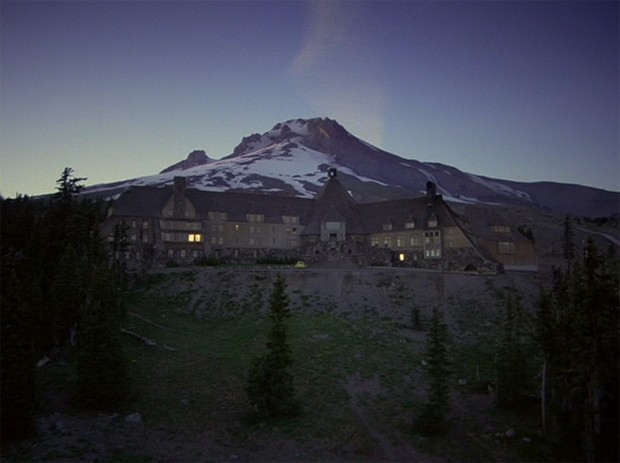
Fig. 1 - The lodge on Tuesday evening, the sun setting in the west, northwest.
182 Title shot. Tuesday. (40:28) Previous was "A Month Later". Now we begin with the weekday titles, the first of which is "Tuesday".
183 LS exterior lodge. (40:31)
A shot of the Overlook viewed from further down the mountain at dusk, a single light shining in the first floor to the right, two double in the left wing and perhaps yet another. The VW is in the parking lot. The sky is clear except for a vague yellow haze of cloud above which one can take an alternate perspective on and hazard it looks much like a diffusing spiral plume of smoke rising from either the lodge or the mountain. That we are to make a connection with smoke as well is possibly had through the establishing shot in the "A Month Later" section showing smoke spilling from the Overlook/Timberline's right chimney. If we are to view this as smoke, another connection could possibly be drawn to the Calumet (peace pipe) as well as the idea of it as a form of stairway (which I write about about when discussing the storage room in the Closing Day section).
Or it could just be pretty. It may be nothing but an interesting shot.
184 Crossfade from exterior of the lodge to Wendy in the kitchen. (40:36 begin crossfade, end 40:39.)
Crossfade to Wendy, in a blue and white striped apron, looming over the mountain and lodge as a giant, opening a giant can of fruit cocktail, a bread package with stars on a blue field to the side on the counter. With the crossfade from the mountain to the kitchen, her operating the can opener taking place over the lodge forms a circular motion above it, even seeming to slice through the upper portion of the mountain. This recalls a shot of the mountain in the Closing Day scene, the top of the mountain wrapped in fingers of reaching cloud which had a distinct circularity of motion. That shot had been preceded by a crossfade in which the VW appeared to be driving up to a tunnel through the lodge/mountain, again recalling the Carson City movie.
This is the last view we will have of the mountain in the film, for in the remaining shots of the lodge the mountain is obscured by a blizzard, disappearing completely into the watery blue tones of a white out.
Note to the left of the mountain slope leading up to the lodge, there are two tracks. At first glance they appear to be duplicated on the right. But those apparent two tracks on the right are not part of the terrain, they are instead formed of the horizontal stripes of Wendy's apron. It's a very precise and absolutely purposeful mirroring that forms a deliberate arc. As with so many details, this took some planning to ensure the pocket of Wendy's apron drooped just precisely so that those top two lines of her apron's pocket mirrored the terrain on the left. Visually, this can recall the rainbow mural in the Colorado lounge, in which the rainbow spirit wraps around the bottom of the painting, the blue corn appearing to even grow out of it. I've no idea if this is supposed to recall that image or not.
The circular track also visually reinforces Wendy's circular cutting motion with the can opener, coincident with the impending cutting off of the lodge and isolating it from the rest of the world via the snow storm.

Fig. 2 - Wendy cuts open a can of fruit cocktail with the can opener.
The lower arc of the apron also recalls the arc on the maze map.
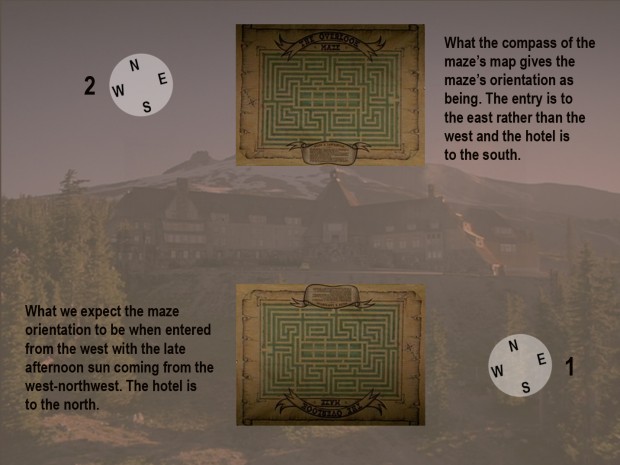
Fig. 3 - On the maze map, from the "A Month Later" section, showing the expected orientation in view 1 of the lodge, and the orientation in view 2 given by the compass of the maze's map.
In Carson City, the movie Wendy was watching on the day of the interview, when Jack phoned to say he had gotten the job and Danny experienced his first shining of the lodge, there had been the synchronous occurrence of seepage in the Carson City tunnel that was being blasted through the mountain. Once Silent Jeff and his crew were inside the tunnel, checking it out, they were blocked in by an avalanche, but were rescued through the second tunnel that was being dug in the opposite side of the mountain. Upon being rescued, Silent Jeff immediately went to the mountain top to look for the how of the avalanche. Up above he finds a "drill hole" in the mountain side that looks like a slice taken out of it, as well as powder burns, which reveals the avalanche was started artificially. As noted in the Interview section, The Kubrick Corner shows that continuing from the point where we see the movie behind Wendy in the living room, running it in real time, when the blood is shown gushing through the elevator shaft in Danny's vision it matches up with a discussion in Carson City on the leak having been found in the tunnel that's then under construction. This is so precise, it's not likely to be coincidence, and so it's worthwhile that we look for other possible linkages.
Kubrick's treatment of the mountain visually compares with Close Encounters, which I've written of at some length in a special post at this link, for it's after the mountain is decapped in Close Encounters...

Fig. 4 - The top portion of the mountain accidentally snaps off in "close Encounters".
...that Roy sees that his sculpted tower, over which he looms like a giant, is the same as Devil's Tower, which he coincidentally views on television.

Fig. 5 - Roy sees the inspiration for his sculpted model on the news.
And it's at that point in the film that Devil's Tower is isolated, cut off from general society, while those who have been "called" to it attempt to make their way there. It is this way in fairy tales. One is warned away from what becomes a single-minded pursuit. For the sake of the story, once the warning is given, the journeyer must defy it. Their yearning for knowledge must be satisfied.
There is some semblance visually with our having just observed Jack looming over the miniature of the maze, then having a giant Wendy slicing open the can overlaying the mountain top, which is thus visually removed from being observed for the rest of the movie by a snow storm that will also physically isolate the Torrances and the lodge from the rest of the world, which Wendy now learns about on the television.
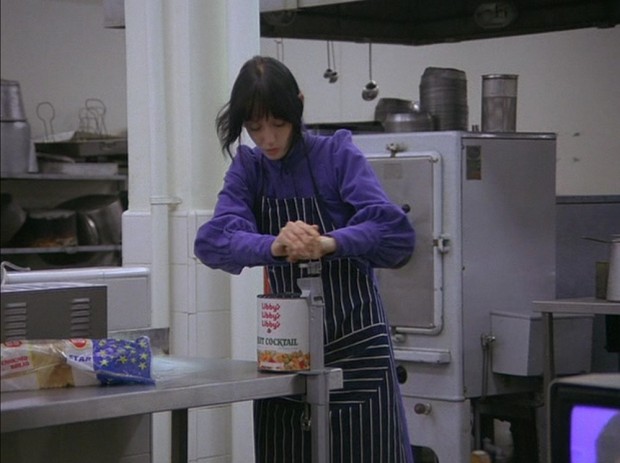
Fig. 6 - Wendy working away at opening the can.
Our last view of the kitchen had been on Closing Day when Danny was eating ice cream at the table, talking to Dick about shining, and Dick had warned him away from Room 237.
A television rests on the dining table now. A newscast running, the report concerns a life conviction for a 1968 shooting then switches to a news update on a search for a 24 year old Aspen women, Susan Robertson, who has been missing in the mountains 10 days, having disappeared while on a hunting trip with her husband. They may have to call off the search as a snowstorm is predicted to move in.
As Wendy dumps the whole contents of the oversized can of fruit cocktail into a large yellow bowl it seems now that a pint sized Wendy is preparing a meal for a family of giants, the can unwieldy in her hands, bringing again to mind the fairy tale of Jack the Giant Killer. And Wendy, though small in relationship to the can, is larger than the news woman and weatherman displayed on the television, and the news woman and weatherman far larger than several of Danny's toy cars that rest at the base of the television.
I think back to the Orson Welles' film in Himberama, referenced in Killer's Kiss and recall how the cinema screen Orson, interacting with the audience, says, "You know it's remarkable, but on the screen some objects enlarge quite unusually."
The fruit cocktail is predominately yellow and is poured into a yellow bowl. In the previous section, Wendy had served Jack sunny-side up eggs and orange juice and bacon. Wendy licks some of the syrup off her finger, which, aside from a small bite of sandwich she had during lunch on the day of the interview, is the only food she'll be observed to eat in the movie.
The leftovers! They'll be dining on fruit cocktail for a week.
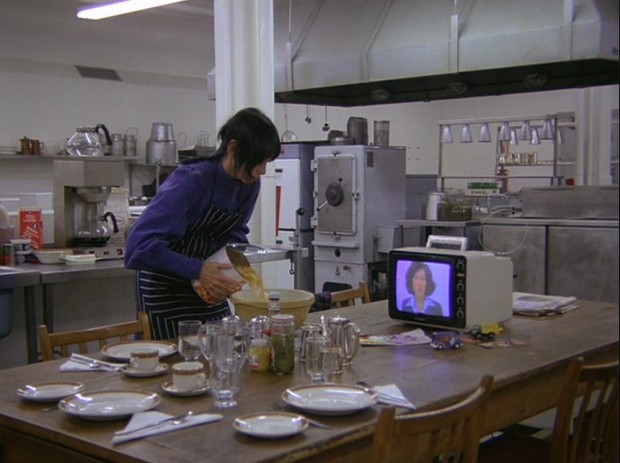
Fig. 7 - Watching the news while preparing dinner.
The manner in which we were shown the kitchen on Closing Day, though given a good overview, perhaps left the viewer disoriented as to what is where in the kitchen, in keeping with Wendy describing it as a maze. We saw the table before the storage room but only briefly and the viewer may be uncertain if the table is parallel or perpendicular to the storage room. I know that for some reason I always used to view this scene as though the table is perpendicular the storage room, and I think it has to do with the corner wall behind and the manner in which the kitchen was unfolded. Kubrick had Dick and Wendy and Danny enter, turn screen left, then left, then left again, but always with the group walking toward the camera. He led us around the back of the kitchen to the locker hall, so that we saw equipment and the walls behind the equipment, a confusion of white and aluminium and steel surfaces, nothing standing out on its own as a marker, not giving us a glimpse of the very corner of the oak wood table until we were already in the vicinity of the lockers. Though we were later, briefly shown the table is parallel the storage room, here I see the walls behind and orient our position by virtue of the corner, visualizing it as the left rear corner when one is facing away from the storage room, which turns me 90 degrees so I'm seeing the table as perpendicular the storage room. Instead this is the right rear corner when one is facing away from the storage room.
WOMAN REPORTER: ...was serving a life sentence for his conviction in a 1968 shooting. And the search continues in the mountains near (unintelligible) today for that missing Aspen woman. 24 year old Susan Robertson has been missing 10 days. She disappeared while on a hunting trip with her husband. They have good weather right now but they may have to call off the search if a predicted snow storm moves in tomorrow. Sonny, it's so beautiful in Denver here today it's hard to believe a snow storm could be that close.
WEATHER FORECASTER: I know. I want to go outside and lie in the sun, yet to our north, our west, it is snowing and cold and it's moving right here towards Colorado, right now as we talk. It's incredible.
Just as the Carson City movie had synchronized with Danny's shining of the bloody elevator, here the news report of the blizzard that's on its way finds a kind of echo in Wendy dumping out the fruit cocktail which echoes also the Carson City avalanche.
When Danny had shined the bloody elevator and the two girls, he had been wearing his "42" shirt on which were white stars on a band of red on his sleeve. Here we have also a recurrence of the stars, this time on a field of blue on the wrapping for a loaf of bread, and an inversion of 42 with the age of Susan Robertson given as 24.
The way these things usually go, Susan is likely, pitiably dead (24 happens to be the path of NN on the Tree of Life, which connects the 6th and 7th sephiroth, the corresponding Tarot card being Death, which probably has no bearing on anything but I thought I'd toss it in), and doesn't even much attract Wendy's notice here as Wendy later neglects to tell Jack about the missing woman, but for those looking for physical rather than paranormal causes in the movie Susan Robertson does become an opportunity for explaining away Danny's being choked in Room 237. Some members of the audience will think back on the missing woman and wonder if she is also there, a secret and unnoticed resident at the large lodge. Some suggest that it's Susan, having found her way to the lodge, who is the crazy woman Danny encounters.
The way these things sometimes go, Susan will have been murdered by her husband, who reported her as missing.
A sort of dialogue of correspondence happens between Danny's being "found" earlier, and then this missing woman, as the woman who found Danny was a Susie and the missing woman is a Susan. The red-headed Susie had been a reassuring presence.
The next scene will be Danny riding about the floor outside Room 237 and trying its door. The last time Danny had been shown making a circuitous journey it had been in the area of the Colorado Lounge a floor below, a scene that had been followed by his mother delivering eggs "sunny side up" to Jack in their homely little suite, Jack shown reversed in the mirror, talking of his sense of deja vu at the hotel, and here we've just had the weather and news reporters discussing how sunny it is outside, the forecaster even named "Sonny".
The scene of Wendy making dinner while watching television is so pedestrian, ordinary and everyday that, by virtue of the way in which Kubrick manages to film such with a great deal of frank intimacy, the viewer may feel themselves a sense of deja vu, just as the viewer might have strongly connected with Danny watching cartoons on the television while eating his lunch. Though the place is unfamiliar, for the 1970s viewer, watching news on the television while making and eating dinner was a ritual repeated in home after home.
DANNY TRIES THE DOOR OF ROOM 237
DANNY'S CIRCUIT OF THE FLOOR ABOVE THE COLORADO LOUNGE - THE UNOBSERVED OPEN DOOR OPPOSITE ROOM 237 - THE GHOST DOORKNOB - DANNY'S THIRD SHINING OF THE GIRLS - THE FALSE ILLUSIONS OF THE LODGE BLEND WITH THE ARTIFICIALITY OF THE MOVIE SET
185 Low shot rear of Danny tracking him in Room 237 hall. (41:13)
Cut to, from the rear, a view of Danny dressed in blue overalls and red sweater, zooming on his trike down a guest hall of the hotel over a carpet of hexagonal red, black (or sepia) and orange graphic elements. He passes an open stairwell door on the right, its light shining greenly, red doors of an elevator to the left of him.
We are trained to be alert to these red elevator doors, looking for the ones that will spill blood, and due the carpet we are aware these aren't the ones.
Danny appears to be wearing the same clothing that he wore in his Big Wheel circuit of the Colorado Lounge in the "A Month Later" section.
In the Blu-Ray version I have the stairwell isn't near so green, more a cream color in this shot, though it is green in a later view. However, I well remember the stairwell as having the greenish tint here when we first viewed the film in the theater so the Blue-Ray is in error. The green conjured a sense of anxiety, of something "other" lying in wait. It had remarkable presence.
Having already experienced Danny's Big Wheel cycling about the lodge from this rear perspective, we are now somewhat accustomed to it and believe we know what to expect. That said, when one has never watched the film before, the carpet is novel, and the large, repeating, bold graphical design is what's going to be riveting the eye. The carpet is a lot to deal with and absorb when first seen, the wow factor of it, and the viewer feels as though they're being otherwise attentive, grasping the whole, as they notice the open stairwell doors and that green light that throws in a touch of the eerie. That carpet and Danny, however, occupy all one's focus.
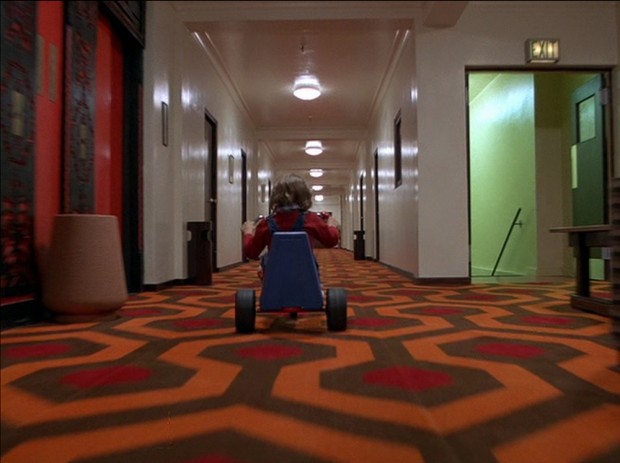
Fig. 8 - Danny begins his tour of the floor above the Colorado Lounge.
Danny continues down the hall of mostly single doors and an ominous note sounds as he passes double doors to a room on the right. He takes a left into an uncarpeted hall with the red doors of another pair of elevators on the right, these being oriented perpendicularly to the others we saw earlier. This is the hall above and behind Jack's desk in the Colorado Lounge. Just before Danny takes the left into this portion of the hall, we're given a brief glimpse of a picture above, and it looks much like a faceless Danny looking down on himself. The design of the shirt looks like his raglan, the one with the stars and 42, which he had worn during his initial shining. That is the first odd peculiarity in this run, the entry of the idea of Danny overlooking himself as he zips about the Overlook, not too unlike Jack standing and overlooking the maze.

Fig. 9 - The picture before Danny turns left before the second set of elevators.
In the balcony hall, as Danny reaches the stairs, we see hanging down from above a slap-in-the-face of plastic sheeting. I call it a slap-in-the-face because we don't notice things like this and then when we do they are astonishing, and one may initially wonder if Kubrick is dropping the "real life" facade of the movie and letting the audience catch a glimpse of the back stage.

Fig. 10 - Danny cycles past the stairs.
Why do viewers never see this? I suspect it's because they're on Danny's eye level. Also, no matter how many times they might have seen the carpet, it overwhelms the eye and they've been dealing with that and then dealing with this brief change in floor covering, so that now they're figuring out the different rug and how it relates to the lay of the land. Kubrick movie magic. He knows where your eye is going to go, and it's not going to be to the plastic sheet. Your eye is going to be on Danny and the carpets. Also, you've been just provided another brief glimpse of red elevators and your eye and mind are comparing those with the elevators in the vision. Not to mention your senses are also involved in the overwhelming sound of the trike as it moves from carpet to hardwood floor to carpet.
The viewer may say, "But I bet that plastic sheeting is an error, that it was left over from their working on the set and Kubrick didn't notice it when filming and later figured no one would notice."
Maybe.
Now, notice that not only do we have the plastic sheeting, but there is a portion of it that is swinging on the inside, like a pendulum. This happens very rapidly, about twice, as Danny cycles toward it.
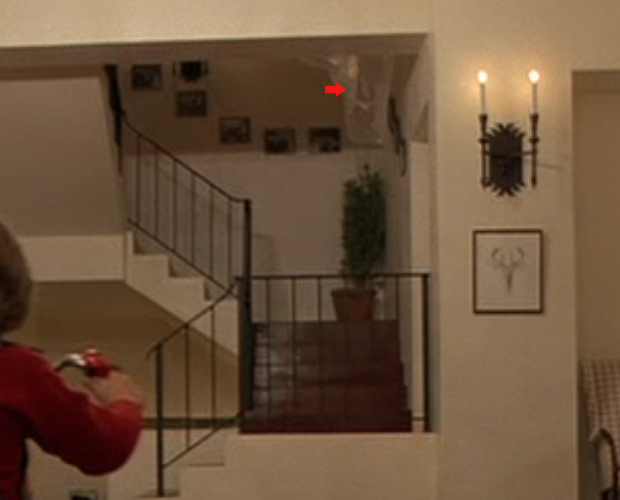
Fig. 11 - The plastic sheeting.

Fig. 12 - The plastic sheeting.
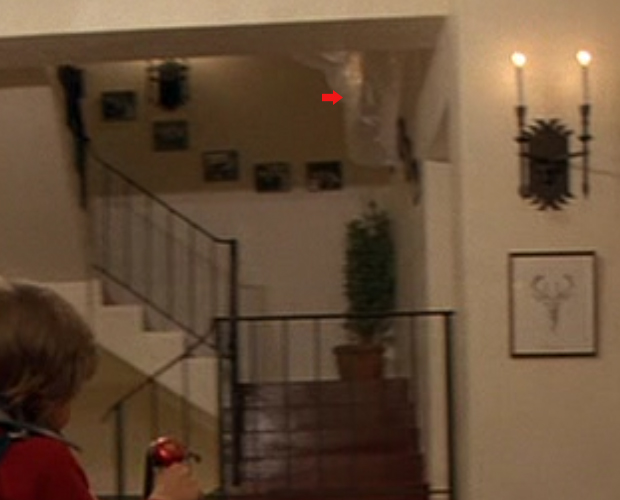
Fig. 13 - The plastic sheeting.
Or, here, try this animation on for size.

Fig. 14 - Gif of the plastic sheeting moving.
The movement of a portion of the plastic sheeting is not a trick of the light. If you go and take a look at the movie and pay close attention, you'll be able to catch it. It reminds of how when Jack is checking Danny's bedroom with Wendy, having returned from Room 237 and reporting on finding nothing, we can briefly see in the background the green key swinging in the door to the Suite.

Fig. 15 - Gif of the green key moving.
What unites these two objects? There are only a few things in the movie we are able to observe moving as if of their own volition. On "Closing Day" we'd observed the plastic shower curtain in the Suite 3 bathroom moving. Here, on Tuesday, when Danny is about to try to open the door to Room 237, we see plastic sheeting that brings back the idea of the curtain, and independent of it in the center we have a pendulum-like portion that is swinging. Then, on Wednesday, after the Room 237 encounters had by both Danny and Jack, and our observing the red key in the Room 237 door (even Jack locking the same as he left), we see the green key in the Suite 3 door and it moving independently. Perhaps a link is being made between the curtain and the key. I don't know.
Is there a connection to the transparent plastic encasing all the meat in the C-3 meat locker? Recollect that Dick was showing Wendy and Danny into C-4 and then cut and we were instead entering C-3. We are about to have another peculiar incident involving doors on opposite sides of a hallway.
Danny takes a right, another immediate right, then another right, making his way through the maze of the hotel. He passes the double doors of Room 237 on his left, the red doors to the elevators not far away on his right.
He stops and looks back at Room 237, breathing heavily.
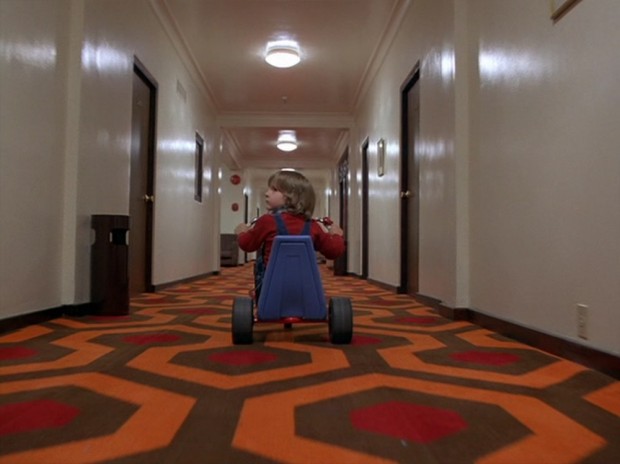
Fig. 16 - Danny,, attracted to Room 237.
186 MS Room 237 through Danny's arms. (41:51)
We have a shot from below and behind of Danny looking back up at No. 237.
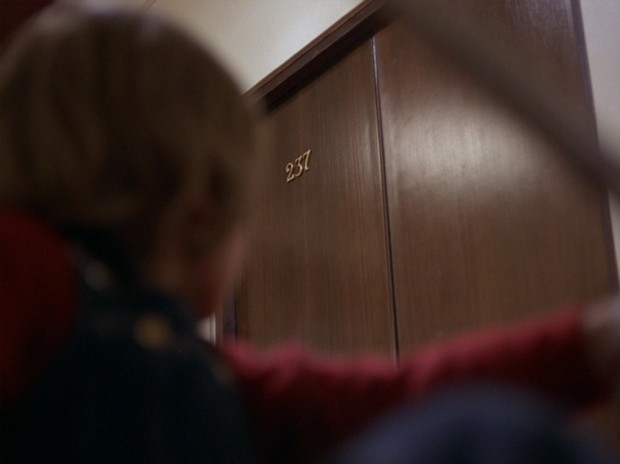
Fig. 17 - Looking at Room 237 from below and behind Danny.
187 CU Danny. (41:55)
There follows a shot of Danny and the laundry bin and door at the far end of the hall.

Fig. 18 - Looking at Danny looking at Room 237.
188 MS Room 237 door through Danny's arms. (41:58)
Again, another shot from below and behind of Danny looking back at Room 237.

Fig. 19 - Room 237 from below and behind Danny.
189 MS. (42:02)
Return to Danny. He rises from his Big Wheel and approaches Room 237.
And did you notice that the door just beyond and opposite Room 237 is open now?
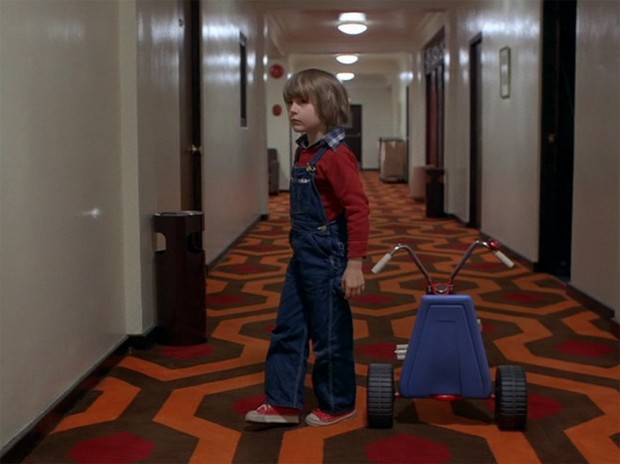
Fig. 19 - Danny rises to approach Room 237.
I dodged out the area of the door in an image below and as you can see it's definitely open. The floor appears to be carpet perhaps like that in Room 237. I can't tell. It is blue or blue-green. Curiously, if you really dodge it out, you see the bit of "room" beyond may be unfinished set. It may be the floor is just also unfinished set.
We also see a peculiar yet ordinary light effect on the wall next to Room 237, a shining that looks almost like a phantom doorknob. This may very well be a reflection of light off the metal tray of the nearby ash can, but that it is so obviously there leads me to think it's not insignificant, especially as it resembles a door knob in form and we have a door across the hall that is open but hidden, and we have Danny about to try a doorknob to Room 237. That's a lot of focus on doorknobs. It's a big moment in the film, Danny approaching Room 237, and is surrounded with door/doorknob peculiarities.
I wonder if that phantom door knob on the left speaks to the fact we are viewing a phantom door knob on the right. The viewer sees the dark space on the right, the glint of metal, and accepts this is a closed door and the glint of metal is a door knob. After all, in a previous shot they'd seen the door was closed. But that glint of metal is the latch plate in the door frame rather than the door knob, and that dark space is not the closed door but an open door. Our minds have formed the phantom door knob. It isn't there. The phantom door knob on the left, in a way, remarks on this. It too, after all, is a phantom, likely formed via the ash can, but it is a phantom of which we are aware from the beginning as Kubrick has positioned it to stand out. This phantom will catch your eye long before the absent door.
If that phantom light is off the ash can, one will notice that it wasn't there when Danny came to a halt to look back at Room 237, the door of the room on his right still closed.
When you realize the door is open and that this phantom door knob perhaps alludes to it, you kind of go, "Damn, what else have I missed in this film?"
We had this phenomena before also with Dick appearing to show Danny and Wendy into the C-4 freezer but then instead entering the C-3 meat locker that was not exactly opposite in the hall but opposite and down a door, just as this is opposite and down a door as well.
Danny attempts to enter the door to Room 237 but it is locked while the door opposite and behind him is wide open.
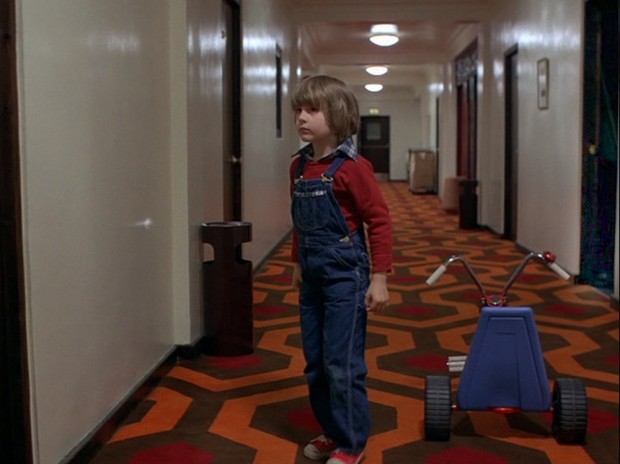
Fig. 20 - Danny steps toward Room 237.
Tempted, unable to resist (as it is with most heroes in fairy tales) Danny touches one of the doorknobs and attempts to turn it.
When Danny raises his hand to the doorknob, he holds it in a rather peculiar manner, a thing which many have noticed.
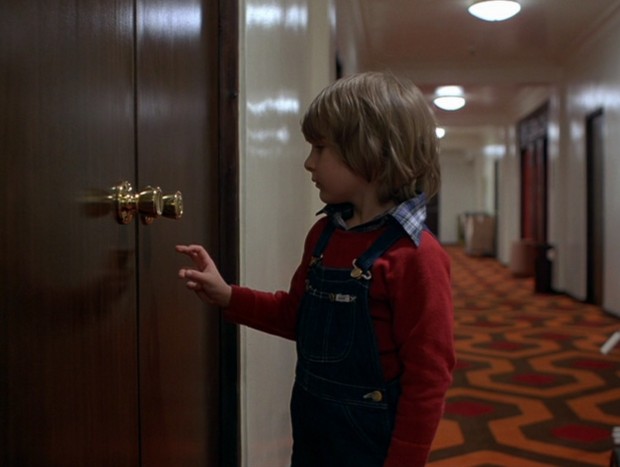
Fig. 21 - Danny raising his hand to try the lock.
It eventually occurred to me that we see reflections in these double doors and they are acting as a mirror. We see a reflection of one of the knobs (which anticipates the odd double knob in the Saturday section). We see shadows of the knobs as well. We see a shadow of Danny, as well as a reflection of his hand and arm. Consider that, the way in which he holds his hand, it reflects an apparent symmetrical figure in the door, one side of the hand seeming to mirror itself and project the other. Humans recognize themselves in reflective images. Animals might see another animal that acts as they do.
Danny tries the knob twice. The door is locked. We can almost feel something or a phantom someone on the other side holding the door closed. Taking his hand down, he looks up at the number 237. This number is on the left hand side of the door, whereas all the other double doors in these halls have the room number on the right hand door.

Fig. 22 - Danny looks up at the number.
190 MS The two girls. (42:44) A vision of the two girls glances through his mind.

Fig. 23 - Danny sees the two girls.
It is when Danny looks at the number 237 that the girls glance through his mind, just as they had appeared when he was in the game room and playing darts, facing the 732 (237 in reverse) on the dart board.
191 MCU Danny. (42:45)
Return to Danny looking up at the door. As Danny climbs back onto to his Big Wheel, he keeps glancing back at Room 237 over his left shoulder, which keeps our attention on Danny and his focus on the left. When he isn't glancing back to the left he keeps his head down, looking to the floor, such as observed in the image below of him passing the still open door on the right.

Fig. 24 - Danny furiously cycles away from the room.
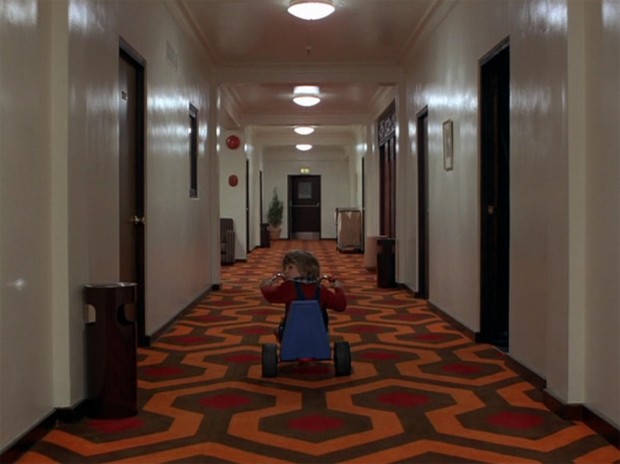
Fig. 25 - Danny glances back at Room 237 as he passes room 236
It is only when Danny is back around the elevators that he lifts his head and keeps it up as he cycles, just as his head had been up as he rode all around the floor before approaching Room 237.
This is fascinatingly screwball, as Kubrick has done his best to make sure we don't notice the open door, even while placing it right under our noses.
The room number of the open door is seen finally on Wednesday and is 236. Kubrick references this in Eyes Wide Shut. After Bill's encounter with the bald man before the Verona restaurant, the number of which is 237, and he picks up the paper in which he learns of Amanda being hospitalized, he goes to the hospital. As he enters it, we see beyond the hospital's revolving door the number 236 on an opposite exterior wall. I assume the hospital, where Bill finds Mandy in the morgue, is 237.
Danny's Big Wheel ride about the floor of Room 237 was not the simple circuit made of the Colorado Lounge. Looking at the design it makes, one could possibly view it as forming a meandering "Greek Key" labyrinth shape. (The below image is a screenshot from a website on Greek keys.)
The Greek Key is so called because of it resembling the shape of a key. And yet the door to Room 237 is presently locked to Danny, while the one across from it stands open on an utterly impossible room, and Danny keeps his head down and turned away so that he won't notice it, nor will we.
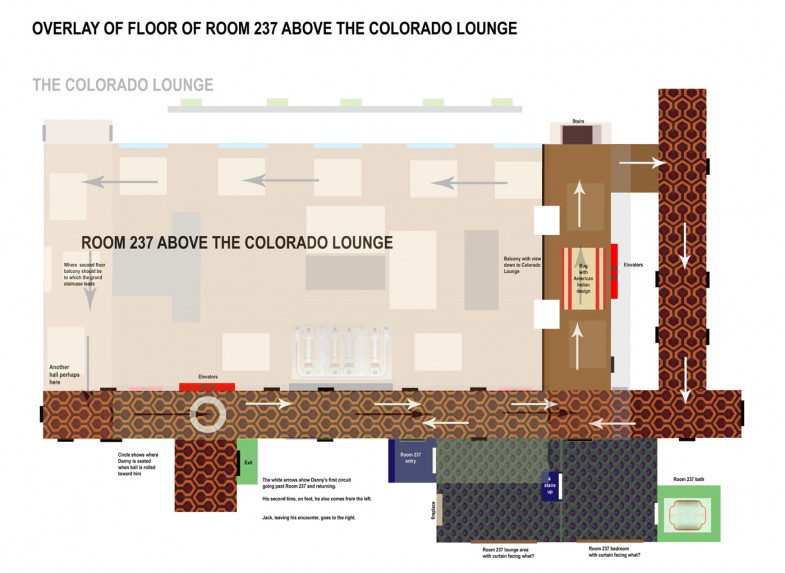
Fig. 27 - Map of the second floor above the Colorado Lounge.
What we have with this section is a further revelation of just how impossible the majority of the lodge is. Beginning with Danny passing the elevators on the left and the green stairwell on the right, the path Danny takes around this floor above the Colorado Lounge is one oddity after another. The red elevators on Danny's left, as he begins his journey, where do they go? There is no elevator in the same position on the Colorado Lounge floor beneath. There are red panels that mimic the red elevator but they instead are only decoration to either side of a door. Does the elevator only connect this floor with ones above? No. As we've seen, the elevators show a basement level, a lobby level, and floors 2 and 3. The Colorado Lounge is on the L level, the same as the Lobby. It's the rare elevator that would only serve the upper floors, not even descending to the ground level, and so I suspect this elevator to be "impossible", just as the majority of the doors on the hallway lead to impossible rooms as there is no space for them at all, they are doors to nothing.
Take a look at the above map of the floor. All the doors opposite Room 237 are as illusory as the illusory door behind the illusory phantom door knob, leading to rooms that don't exist. The airy emptiness of the upper reaches of the Colorado Lounge is on the other side of that section of wall which is but about two or three feet deep, this clearly exposed when Danny turns left into the hall above and behind Jack's desk. There is no place for the rooms to exist. When he takes a right and another right into the halls behind the elevator in that balcony area above and behind Jack's desk, we see that again the doors lead to impossible rooms, certainly those on his right and likely the others. Those doors would lead to spaces the size of a closet and with no windows. One could plead a deliberate compression of space that's not supposed to be noticed by the audience, and that the condensing gives the illusion of a full hotel floor while taking up less area, but I don't believe that is what's going on here. This circuit Danny makes of the floor, I believe, deliberately points out and highlights the illusions of the hotel and the artificiality of a set construction which has had us convinced, on a first viewing, that everything is just as it should be and there is nothing out of the ordinary about it. Because the camera and characters are accepting, we accept the impossible, and not even by virtue of a radical suspension of disbelief. The audience is unaware of what has been so deliberately shown them--they have no idea at all that the majority of the set is impossible. They've no idea these impossible doors lead to nothing, which gives a different twist on Dick Hallorann's assertion to Danny that there is "nothing" in Room 237. Nothing. About the only room that is possible on this entire 2nd floor is Room 237.
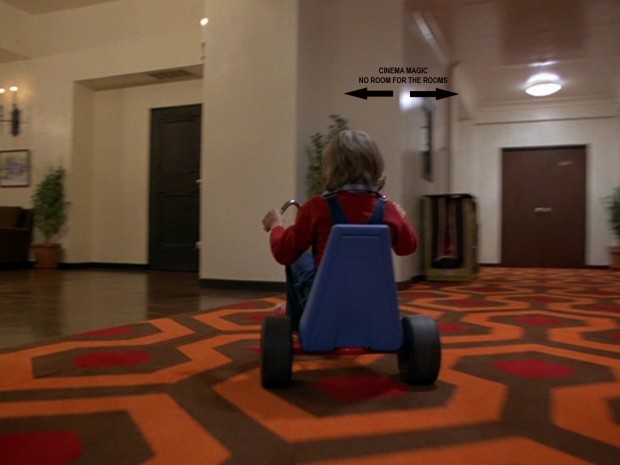
Fig. 28 - No room for rooms in this area and yet there are doors on the hall behind as if there are hotel rooms.
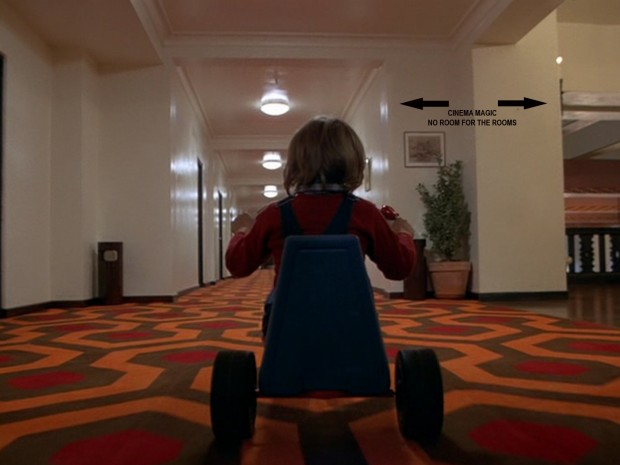
Fig. 29 - No room for rooms in this area, and yet there are doors which make us feel there are hotel rooms.
Even the door to the green stairway, being opened as it is, shows how deep that stairwell is, occupying a considerable amount of space so that the first right door on the hall is also one that leads to an impossible room, which is the only door on that side of the hall preceding Room 237.
Indeed, the only functioning guest room in this hotel will appear to be Room 237.
Where the heat is not on in the winter.

Fig. 30 - The length of the stairwell allows no room to be where the first door in the hall is on the left.
So we have impossible rooms and an open door, opposite Room 237, that leads onto what appears to be set construction.
It's like Kubrick pointing out the magical power of suspension of disbelief that humans can use to such an extent that they don't notice how flimsy "reality" can be found to be when it's built on things we've simply accepted as others accepted and taught.
Here's another view of the open door opposite Room 237 dodged out even more, and the "doorknob in the wall" burned in so that we can tell it is indeed a doorknob.
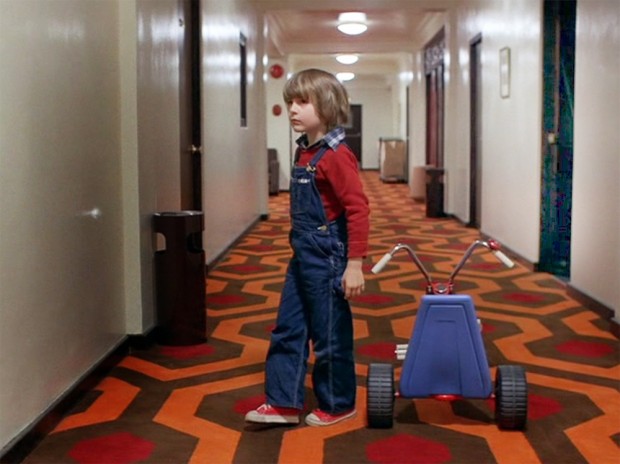
Fig. 31 - The doorway of room 236 dodged out.
Why the door is open but this is concealed in darkness so we don't notice it is one thing. Why the open door leads to an unfinished room that looks like the rear of a set is another. Just as the peculiar plastic sheeting observed hanging down in the stairwell is a bizarre detail that goes a step beyond the puzzle Kubrick lays before us with a largely impossible floor plan.
Because Danny's visions have been linked with Jacob's ladder and I sometimes wonder if we might look upon different parts of the lodge as expressions of Jacob's ladder and the Kabbalistic Tree of Life (here is my personal Rorschach) I have considered if the shower curtains refer to the the Veil of Paroketh which stands Kabbalistically between the upper and lower realms, said to be a barrier between the upper soul and the lower ego where all is an illusion.
Enlightenment-Jewish Style gives the following from an interview with Rabi Gershon Winkler.
Magic is about maneuvering, or rather engaging the parallel universe of the spirit world. We live in a physical manifestation of the planes. So magic is basically being in the plane where you are and reaching across what we call the veil, or the Paroketh, and living in the illusion of both universes, maneuvering from one universe to another. If I want to turn the tree into a stone or a stick into a snake, I have to go to that plane that manifests the stick and manifests the snake. I have to go way to the many, many realms of interpretation of what is spirit into what is matter. I have to go way, way up to the root because the farther through the realms you go into the spirit world, mostly you come to the root of everything, that's called The Tree of Life. Actually in Hebrew, it's the tree of many "lives." It's a plural word. Chaim is a plural word meaning lives. So it's one tree of many, many lives of wood, of tree, of rock, of people, of animals, and of planets.
Without going further into the idea of PRKTh, the veil, I could see how we might (or might not) have a maybe, possible, even if unplanned correspondence with the veil/plastic sheeting, and this decidedly illusory territory Danny has been navigating, where there is so much that is not as it seems to be.
Does this really work? The idea of the veil? I don't know. I don't throw it on the trash pile yet because it still seems ponderable at times.
There is another possible connection between the doors and the swinging pendulum in the middle of the plastic sheeting. The root stem of DLTh, or door, is DLH, which means to hang, pendulous. From this comes the idea of the leaves of a door (such as a double door), leaves or branches hanging from a tree, and also thread, as in thread hanging from a loom.
If we are looking at a maze, such would be the thread of Ariadne. Though, as a loose, hanging thread there can be the connotation of poverty, illness, premature death.
All that is fun to consider but if we return to the freezer off the kitchen we do actually have something physically that unites the sheeting and the weirdness with the doors and the girls appearing. Kubrick has set up a pattern.
We have the plastic of the shower curtain in Suite 3 that had been independently moving on Closing Day.
That transparent sheeting hanging down from the stairwell also brings back this.
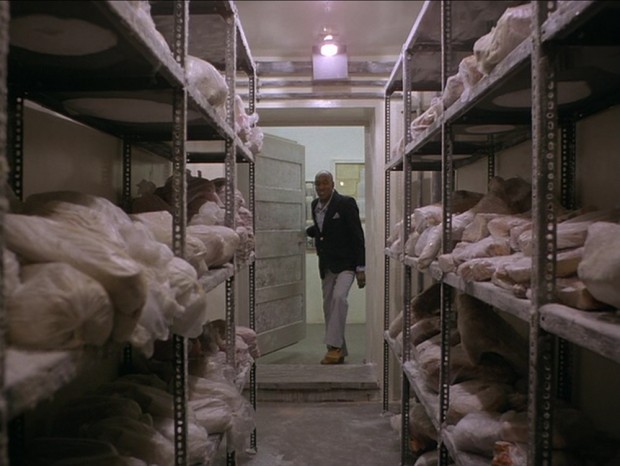
Dick shown entering the C-3 meat locker, rather than C4.
The plastic encasing all the meat in the C-3 meat locker. We must return to the confusion with the C-4 freezer and the C-3 meat locker in the kitchen which also, as I said in that section, refers back to the dart board in the Game Room where Danny again saw the girls. I wrote about how we've the blackboard on one side as they begin to enter C-4, then when Dick exits it is instead from the C-3 meat locker (where Dick asked if lamb was Danny's favorite food) and the blackboard is on the left, in its natural place, but for all intents and purposes it is doubled, and "between" we've the three red lights recalling the 3 red darts on the dart board between the black boards in the Game Room, which is what Danny is facing when he feels the girls behind him and turns to see them. Kubrick has connected these things. That Game Room scene is connected with the freezer confusions (enter one side, exit the opposite) and now Danny trying Room 237 and finding it locked while an opposite door is open.
At any rate, the audience believes in this section that Kubrick has shown us the territory of the upper floor where Room 237 resides, but what Kubrick has instead actually shown us is that there is no functional room on this floor but for Room 237. Not a single one of the other rooms is anything but illusory. There was no reason for it to have been this way. The set could have been designed so that Danny's circuit took him down perfectly plausible hallways. And Kubrick could have chosen not to use shots that revealed impossibilities.
JACK WORKS
MANY CHANGES IN THE COLORADO LOUNGE AND SOME COMPARISONS WITH A CLOCKWORK ORANGE - THE NEW RULE
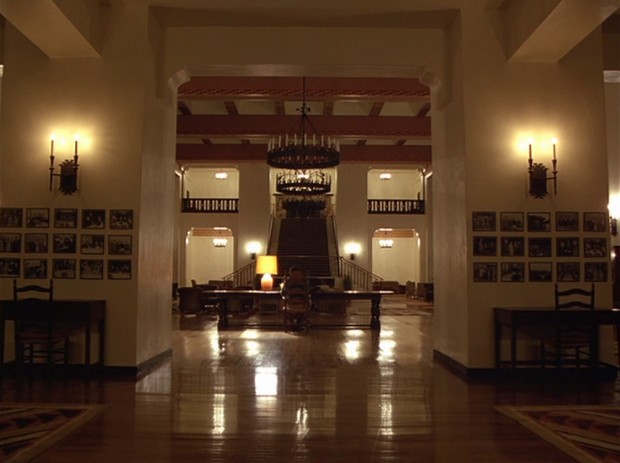
Fig. 32 - Jack is finally at work.
192 LS zooming in on the Colorado lounge. (43:04)
The camera approaches Jack from behind in the Colorado Lounge, he sitting at the great table typing away. We see the great chandeliers hanging from the ceiling and the great staircase beyond that separates into two other staircases.
There have been several changes to the room. The couch that had rested before the writing table is gone, as are its end tables and the rug that was beneath it and the coffee table before it. We will see that Jack's typewriter is no longer a white one but gray. The driftwood centerpiece that was on the table before the piano is gone. One item has undergone a metamorphosis and the others have simply disappeared.
These are quite a few changes at one go. Most notably missing is the driftwood centerpiece, as it was such a striking visual, the focus of the room. It's hard to get rid of the focus of the room and not have anyone notice it's disappeared. And people do notice, they just don't know what to make of it. They tend to observe the centerpiece is gone, as it quite stood out, but they aren't aware of other changes.
This is the first time we've heard Jack's clatter of the typewriter keys and, as expected in such a large, cavernous room, it is quite loud. We are to assume that Danny's circuit of the floor above the Colorado Lounge has likely just taken place, but we heard no clattering of the keys of the typewriter. There was also still light observed in the Colorado Lounge's windows when Danny passed by above and now it appears to be fully dusk.
193 CU Jack. (43:18)
There is a close up now of Jack from the front and we see the double red doors of the Colorado Lounge elevators behind him.

194 LS from behind of Jack, Wendy entering. (43:29)
Wendy enters from the direction of the great stairway, screen right of it, dressed in red boots and the same indigo-purple dress she had worn in the kitchen, suspenseful music playing. The camera is static as she advances across the full length of the floor to Jack.
It could be said that Wendy's attire bears certain correspondences to the figures in the rainbow painting--the length of her dress, and the style of her boots, in specific a spare angularity of form.
We see that Jack's chair and his lamp have moved. Moments previous, Jack was pretty much center of the table, now he is a little to the left of center.
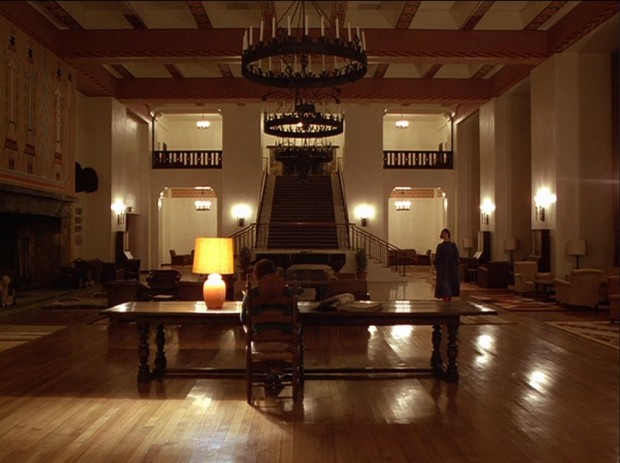
Fig. 33 - Wendy enters the lounge while Jack works.
Below is how the Colorado Lounge was furnished when we last saw it on the day Wendy and Danny entered the maze. Because our perspective has changed and is now more on eye level, the fact that there have been so many changes is pretty well camouflaged, but for the missing centerpiece.
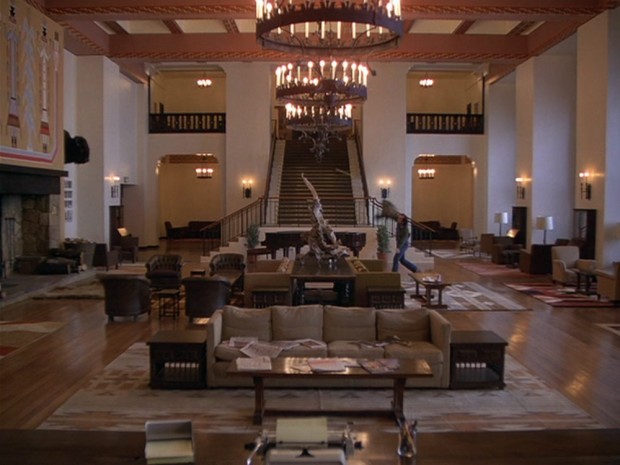
Fig. 34 - The lounge as it was when Jack was playing handball.
We had much the same thing in A Clockwork Orange when Alex returned to the home of Alexander. Alexander's typewriter had been red, but with the return of Alex it is instead gray and we see that some of the seating has been changed in the already spare sitting area that resembled more an art gallery. We don't think much of this because two years has passed and also because we know that Alex had, during the home invasion, overturned Alexander's desk and knocked down the bookshelves behind it (revealing the concealed twin blackboards). So, we assume the typewriter to have been broken. But these things are all connected, and we even have here a lamp with a bright orange ceramic vase that reminds of a bright orange ceramic object that was on a bookshelf beside Alexander's desk (not on the shelves behind). That ceramic object, along with a lamp, had disappeared in the scene where Alexander realized the bloodied young man who collapsed in his entry was none other than the same who had invaded his home two years before. In the scene in which Alexander realizes who Alex is, his features had assumed a version of the grotesque expression that we tend to most associate with Jack. I know that the story is that Jack Nicholson thought up his playing handball with the yellow ball in the Colorado Lounge, but Kubrick had also used a yellow ball in A Clockwork Orange, Alex sticking one in the mouth of Alexander's wife, and then one in Alexander's mouth, gagging them. When Alexander realizes who Alex is, upon his return, the grotesque expression his face assumes, mouth hanging open, eyes rolling back in his head, is much the same as that when he had been gagged with the yellow ball.
In A Clockwork Orange, Alexander is a writer, just as Jack is a writer. Both rely on their wives to do everything for them. Alexander's work space was invaded by Alex and though we empathize later with Alexander's blaming Alex for the death of his wife, we also have the feeling that all was not right between them, that Alexander was not so angry about what happened to his wife as he was about his own humiliation and the loss of a servant. Who invaded Alexander's space but Alex, who was also an expression of the writer himself. In one layer of the story Alex is Alexander's creation, his character. Alex even ends up wearing Alexander's bathrobe and becomes Alex Burgess in one of the newspaper accounts of his attempted suicide, Anthony Burgess of course being the one who had written the book A Clockwork Orange. Kubrick must have enjoyed it that Danny Torrance's alter ego was Tony, taken from his middle name, Anthony. Just as Alex and Alexander were shown on one level to be expressions of Anthony Burgess, their creator, we have Danny also prognosticating events via Tony.
Alexander's space, as a writer, was invaded by Alex, his creation, and Kubrick had worked things so that both Alex and Alexander referred back to their initial creator, Burgess.
Jack's space is invaded by Wendy, and I think we've something of the same going on here as we did with the fictional Alexander and Alex being tied back to their creator.
In Lolita we had the same. Lolita invades Humbert's space when he is writing in his journal and he tells her that he is instead writing a poem. Later, Charlotte stunned by the revelations in his diary, he pleads that what she has found are instead notes for a book.
WENDY: Hi, hon. How's it going?
Jack rips his page out of the now gray typewriter.
JACK: Fine.
She leans in and gives him a kiss.
WENDY: Get a lot written today?
195 MCU Jack from Wendy's side. (43:56)
JACK (stiffly): Yes.
On the desk, in the foreground, is a large scrapbook of pictures and news clips. If one has read the book, one knows this scrapbook has to do with the hotel and that Jack wants to write a tell-all book on its sordid history, but in the movie the nature of the scrapbook is never identified. If one has no knowledge of the scrapbook one would never guess that in it is the history of the Overlook, and that Jack is using the scrapbook as a base for a writing project.
The camera viewing Jack from the side of Wendy, over the scrapbook, we see the false red elevator to the right behind him.
To the left, behind him, is a small table and ladder back chair that is a duplicate of the one he is sitting in and has a seven spoke sun design in the area of the head rest.
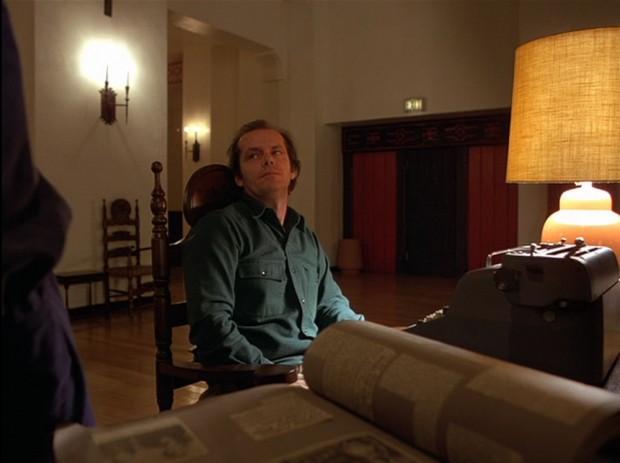
Fig. 35 - Jack just barely keeping from exploding.
196 CU Wendy. (44:00)
Now we view Wendy.
WENDY (stiffly): Hey. The weather forecast said it's going to snow tonight.
The close-up of her face shines against the wall, haloed by light and embraced by vertical slashes of dark curtain.

Fig. 36 - Wendy overlooks the cues that Jack is about to explode.
197 MCU Jack from Wendy's side. (44:07)
Cut back again to Jack viewed low from Wendy's right, over the scrapbook, but now the duplicate chair and table are gone and we see only two heating vents in the wall. The shot so closely duplicates the first that we aren't even aware that this furniture has disappeared, which is one reason it is so bizarre once you realize the furniture is gone. Because otherwise great care has been taken in continuity.
JACK: What do you want me to do about it?
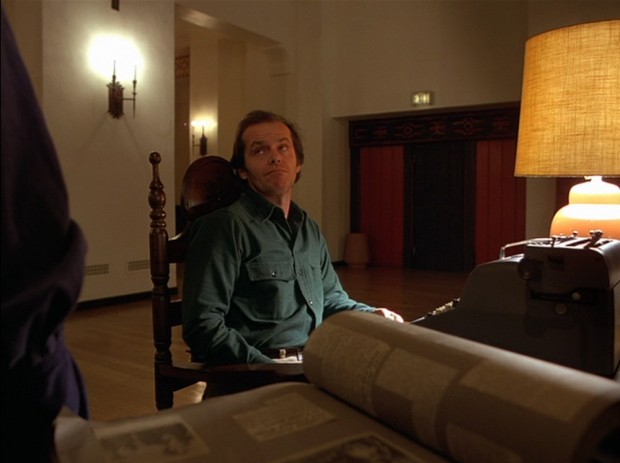
Fig. 36 - A table and chair have gone missing.
198 CU Wendy. (44:14)
Wendy smiles, the camera facing her.
WENDY: Ah, come on, hon. Don't be so grouchy.
199 MCU Jack from Wendy's side. (44:20)
Now back to viewing Jack from beside Wendy, and the chair and table have returned.

Fig. 37 - The table and chair have returned.
JACK: I'm not being grouchy. I just want to finish my work.
200 CU Wendy. (44:28)
WENDY: Okay. I understand. I'll come back later with sandwiches for ya and maybe you'll let me read something then.
201 CU Jack. (44:37)
JACK: Wendy, let me explain something to you. Whenever you come in here and interrupt me, you're breaking my concentration. (He angrily exclaims, slapping his head.) You're distracting me, and it will then take me time...
He rips the paper in quarters.
JACK: ...to get back to where I was. Understand?
202 CU Wendy. (44:55) Shocked, Wendy shakes her head, yes.
WENDY: Yeah.
The audience is a little shocked by Jack's rage, but we know he's going to turn into a monster, and this fulfills our expectations.
203 CU Jack. (44:59)
JACK: Fine, now, we're going to make a new rule. Whenever I'm in here, and you hear me typing, or whether you don't hear me typing, no matter what the fuck you hear me doing in here, when I'm in here that means that I'm working, that means don't come in. Now, do you think you can handle that?
204 CU Wendy. (45:21)
WENDY (otherwise speechless): Yeah.
205 CU Jack. (45:24)
JACK: Fine, then why don't you start right now and get the fuck out of there!
206 CU Wendy. (45:31)
WENDY: Okay.
 198 |
 199 |
 200 |
 201 |
 202 |
 203 |
 204 |
 205 |
 206 |
|
There is a stilted quality to this interchange that should remind of Jack's dialogues with Lloyd and Grady, a certain space between voicings that is revisited most precisely in Jack's conversation with Grady. Lloyd and Grady, both imaginary (or paranormal) figures are framed in a manner similar to Wendy.
 352 |
 353 |
 375 |
 376 |
207 MS of Colorado lounge behind Jack. (45:37)
Shocked, diminished, Wendy complies and leaves.

Fig. 38 - Wendy exits the Colorado Lounge.
208 MS Jack. (45:47)
Wendy exiting, as she reaches the end of the rainbow painting, cut back to Jack observed roughly from the angle of where she had been standing. As we hear her footsteps continuing across the floor, Jack returns to work. The scrapbook shows different images and paper is already in the carriage. This shot of Jack appears out of joint with the others, his temperament and face dramatically different, no hint of rage there, but Kubrick has styled the shot so that Wendy's departing footsteps heard over it tie the cuts together aurally.
The door beyond is now hidden by the lamp. Jack's position conceals whether or not the table and chair, which were there, then gone, then returned, are there or not.
Jack's demand for absolute privacy, no intrusion whatsoever, recalls the legal term for camera.
The chair and table that are briefly absent are mirrored by another chair and table on the left. Their absence is not a fluke, not a break in continuity. In Eyes Wide Shut, we have a similar situation in the apartment of Marion Nathanson whose father dies. When Dr. Harford is in the hall outside her father's bedroom, we see two tables with jade sculptures on them. Soon after, when Marion's boyfriend (a kind of double of Bill) visits and passes down the same hall, one of the tables is now empty of sculptures.
Bill enters Marion's home.
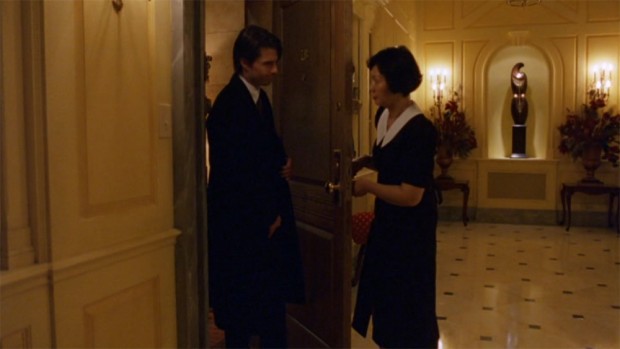
Fig. 40 - Bill enters the Nathanson apartment in "Eyes Wide Shut".
Bill goes down the hall in which we see the jade statuettes.
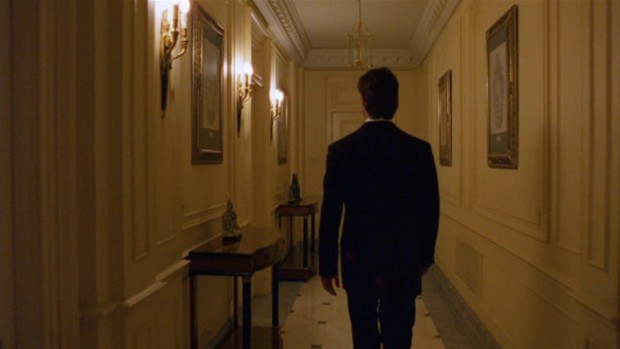
Fig. 41 - Bill passes down the hall to the bedroom of Mr. Nathanson.
Bill enters the bedroom of the dead man, where Marion will profess her love for him.
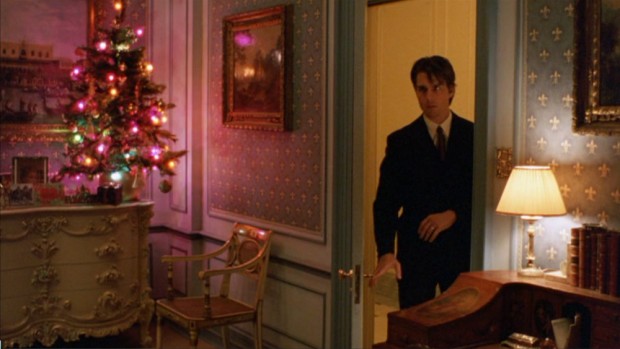
Fig. 42 - Bill enters the bedroom of Mr. Nathanson.
Marion's boyfriend arrives and is shown entering in opposition to how we viewed Bill entering. He functions as a double of Bill. Marion having just professed her love for Bill, with the arrival of her boyfriend we realize she has chosen this boyfriend as a distant substitute physically, the way Kubrick films his arrival making this uncomfortably evident.
Marion's boyfriend goes down the hall and we see one of the jade statuettes is absent.
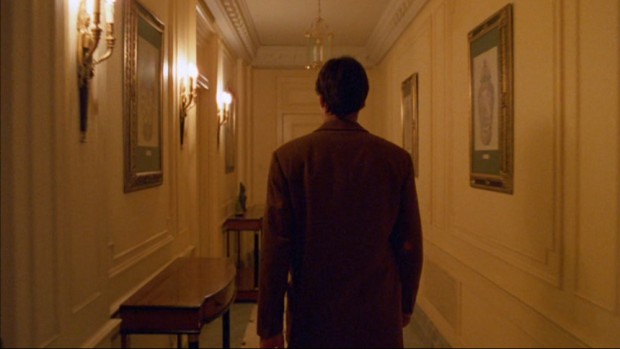
Fig. 44 - Carl walks down the hall to the bedroom.
Marion's boyfriend enters the bedroom, again an alternate, opposing view to how we had viewed Bill entering.
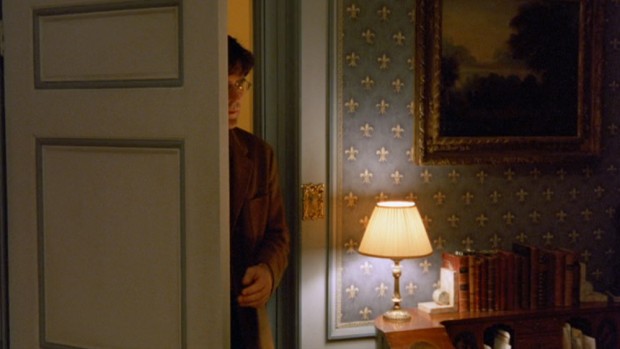
Fig. 45 - Carl enters the bedroom.
One is given the impression that Bill sees the similarity between himself and Marion's boyfriend. Uncomfortable, he leaves.

Fig. 46 - Bill, Carol and Marion.
The boyfriend's name, Carl Thomas, even expresses the idea of twinship, Thomas meaning twin.
In Eyes Wide Shut Bill revisits the same roads over and over again, they showing several different aspects, but they are the same road, rephrased, part of the labyrinth. We have the maze here in The Shining and, we, the viewer, negotiate it throughout the film, not just Wendy, Danny and Jack.
What is it with the disappearing and reappearing stuff
What *is* it with the disappearing and reappearing stuff in The Shining?
I've a theory. But I'll get into it later.
THE FIBONACCI SEQUENCE IN BARTOK's "MUSIC FOR STRINGS, PERCUSSION AND CELESTE" AND ITS RELATIONSHIP TO THE MAZE
Bartok's "Music for Strings, Percussion and Celesta" connects Danny's cycling about the floor of Room 237 with the subsequent scene of Jack typing. The music began as Danny rolled about the upper floor, reaching a crescendo as Danny finished trying the doorknob, seeing the girls, and then moved on to the cycling xylophone scales as the camera zoomed in on Jack from behind, the music ending when Wendy finished her approach and Jack ripped his paper out of the typewriter.
We had previously heard this music when Wendy and Danny entered the maze, it reaching the crescendo as Jack entered the lobby and slammed the ball one last time against the far wall, the cycling xylophone scales playing as he stood over the maze watching Wendy and Danny at its center.
There's speculation that Bartok used the Golden Ratio in some of his compositions and that we can see in the xylophone scales the Fibonacci sequence as 1:1:2:3:5:8:5:3:2:1:1.
How this relates to the Minotaur myth is found in a story concerning Daedalus who built the maze. King Minos had Daedalus imprisoned, hoping his knowledge concerning the labyrinth would thus be kept from the world. But Daedalus escaped. Hoping to locate Daedalus, King Minos let it be known he would reward anyone who could run a thread through the spirals of a conch shell. His reasoning was that only Daedalus would be able to find the solution, and would reveal himself as he would be unable to resist the challenge. Daedalus, who had escaped Minos, did indeed meet the challenge. He drilled a small hole in a shell's center and smeared honey about it, then tied a thread to an ant's leg and sent the ant into the shell, knowing it would crawl through its spirals in order to reach the honey at the hole.
Where do we find the Fibonacci sequence and the golden ratio? In the spirals of the conch shell.
The story of the conch shell is connected with the labyrinth due the labyrinth's early spiral structure. If Daedalus knew the mystery of the labyrinth, he would know how to divine the mystery of a conch shell. You really think someone is going to be able to tie a fine thread about the leg of an ant? The story deals with something else, uniting the mystery of the spirals of the conch with Ariadne's thread carried by Theseus through the labyrinth so he would be able to retrace his way out.
Look up Daedalus and the Fibonacci sequence and you're not going to find anything on it. You'll find discussion on Daedalus and the Golden Mean via his instructing his son, Icarus, not to fly too high or too low but to keep to a middle course--which his son didn't do, he flew too high. But you won't find anything about Fibonacci. That may be because the Fibonacci sequence wasn't created until the 12th century, by Leonard Fibonacci--however, it was understood earlier in India by at least 200-300 BCE.
My reasoning, however, is that Kubrick saw a link between the Fibonacci sequence and the conch shell and the labyrinth and thus the tie in with Bartok's composition in which we supposedly hear the Fibonacci sequence. Kubrick certainly associated this music with the maze as it first plays when Wendy and Danny are in the maze.
Classical ideas of beauty are supposed to be found in Golden proportions, for which reason I imagine Wendy says to Danny, at the center of the maze, "Isn't it beautiful?" Plus, you know, it's beautiful.
Revisiting, for a moment, Jack at his typewriter as Wendy exits (and What I think is the Base Story)
Jack's expression is so different here, in shot 208, I have felt like this is one of the few "real" shots in the film (there are a couple of others), and that the rest are Kubrick allegory world and the horror story is but a fiction upon which Jack is laboring. And that's all right. After all, it's only a story anyway. It's fiction from beginning to end.
The film is full of impossibilities from beginning to end, and I have said repeatedly that one can't approach this realistically. I do think we need to consider that we may have here the story of the writer who is at a lodge typing out his fiction, perhaps one a lot like Stephen King, an alcoholic with anger problems, and his fiction is inspired by this and a working out of it.
This links back up with when Jack enters the hotel and I believe we have a reference to Fellini's 8 and 1/2 with a Marcello Mastroianni like-alike sitting near the door. The film 8 and 1/2 was about a director making a film, inspired by Fellini's life.
HOW WENDY'S OPENING THE CAN, AND THE DISAPPEARANCE OF THE CHAIR AND TABLE ARE RELATED AND COMMENTED UPON BY KUBRICK IN JACK'S NOTEBOOK
So, what is it with all the disappearing and reappearing stuff? As I said a short while ago, I've a theory, and I'm going to try to tackle part of it here. Ninety-nine percent of those who read my theory will think it's cracked. I'm fully aware of that.
Kubrick likes single point perspective shots. Everyone knows this. They're a trademark of his.
Below is an image of a pyramid and pyramidal trapezoid, monolith, vanishiing point and single point perspective all wrapped up in one. We should be interested in these things because they occur repeatedly in this film. How does a variation of the 2001 monolith occur in the below figure? Very simply, the pyramid or pyramidal trapezoid is a monolith viewed from an extreme angle, like you're at the bottom looking up at a monolith that extends into something like infinity. It's from this perspective, in 2001, that we view impossible celestial occurrences, the sun rising over the monolith and the crescent moon above.
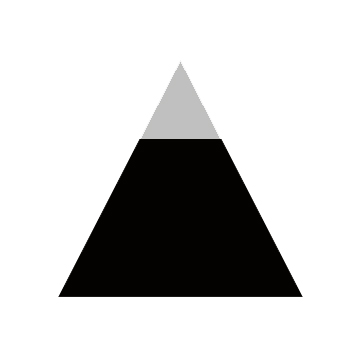
Fig. 47 - Pyramid and pyramidal trapezoid, monolith, vanishing point and single point perspective, all wrapped up in one.
Objects aren't the only things that disappear in The Shining. People do as well.
In the Colorado Lounge, while Wendy looks at Jack's writing, dismayed to find he has been typing the same thing over and over again with variations in format, we have him suddenly appearing from one of the pillar-walls of the Colorado Lounge's entry foyer, though Wendy had gone back in that area to look and see if he was there. When Jack hides behind the pillar in the lobby before he kills Dick, for all intents and purposes he has disappeared, in as much that he is out of Dick's line of vision and out of line of the vision of the audience. Dick doesn't see him just as Wendy hadn't seen Jack when she looked for him in the Colorado Lounge. Jack's hiding behind the pillar in the lobby is more complex than it appears, as I shall eventually show, and we will find combined with it one of the peculiar 90 degree turns that have been happening throughout the film, such as the 90 degree turn before the maze on Closing Day, in which the group went from walking perpendicular the lodge to parallel to it, the physical distance intervening (the corner angle of that 90 degree turn) having been obliterated as if it hadn't happened. It is an absolutely intentional excising with no break in the dialogue. These are physical things that Kubrick has happening in the film consistently, and it may be possible we have here one of those 90 degree turns, combined with a seeming disappearance.
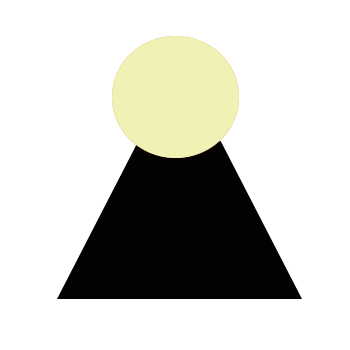
Fig. 48 - Pyramid and pyramidal trapezoid, monolith, vanishing point and single point perspective, all wrapped up in one, but the apex (and, hence, the vanishing point, the pyramid, the angle of convergence) is obscured.
An expresion for these 90 degree/right angle turns and the disappearances and appearances that seem to be associated with them, I find in the "vanishing point" (angle of convergence) of the trapezoid pyramid shape that is repeated throughout the film. Again, when one views this not as just a trapezoid but a rectangle viewed from an extreme perspective we find in it the disappearing angle of the vanishing point.
Kubrick consistently expresses the trapezoidal pyramid shape in the film with a circle above as if obscuring the angle of convergence. Take a look at the sconce on the wall above Jack's head and how we have this expressed even in the shadow created by the light and the bottom of the sconce being what obscures the angle of convergence. This is an example of what I'm talking about. A simple expression of light and shadow and geometry.
We see the same later in the peculiar choking poster.
We see it implied in the Colorado flag.
We see it suggested in the two posters of the women with the afros in Dick's room.
We see it elsewhere in the film but these are good examples. They have become expressions, to me, of the idea of the disappearing angle of convergence, the apex of the triangle hidden within/behind the circle. The vanishing point. A very simple idea. As I've just said, I feel it is expressed in this Colorado Lounge scene as observed with the effects associated with the light fixture on the wall behind Jack, those two lines of shadow that form the legs of the trapezoid leading up to the vanishing point within the sconce, above which is the circle again. Here, the chair and the table that disappear are embraced by the legs of the trapezoid.
With this in mind, I'd like to take a much closer look at Jack's scrapbook that serves no utilitarian purpose in the film. In King's novel, this scrapbook is used by Jack as a resource for a book he plans to write on the hotel and its shady history, but this information is never divulged in the film.

Fig. 49 - Shot 195. Pyramid and pyramidal trapezoid, monolith, vanishing point and single point perspective, all wrapped up in one, but the apex (and, hence, the vanishing point, the pyramid, the angle of convergence) is obscured, as illustrated in the corner of the book.
When we first see Wendy to the side of Jack (fig. 49, shot 195), the table and chair are present under the double light to the rear, and the corner of the screen left page of the scrapbook looks bent or clipped and there is no reason at all to pay any notice to it.

Fig. 50 - Shot 195. Pyramid and pyramidal trapezoid, monolith, vanishing point and single point perspective, all wrapped up in one in the corner of a page, but the apex (and, hence, the vanishing point, the pyramid, the angle of convergence) is obscured.
If we highlight the area of the missing corner, in the above image, we see no corner.

Fig. 51 - Shot 197. Pyramid and pyramidal trapezoid, monolith, vanishing point and single point perspective, all wrapped up in one, but the apex (and, hence, the vanishing point, the pyramid, the angle of convergence) is obscured, as illustrated in the corner of the book.
Now, how does the area appear when the chair and table have disappeared? In the above grab of shot 197 we see the corner of the page. It isn't turned down, but it is in shadow.
The table and chair may be gone but we see the vents now behind them. These forced air vents of the heating system were previously obscured by the table and chair.
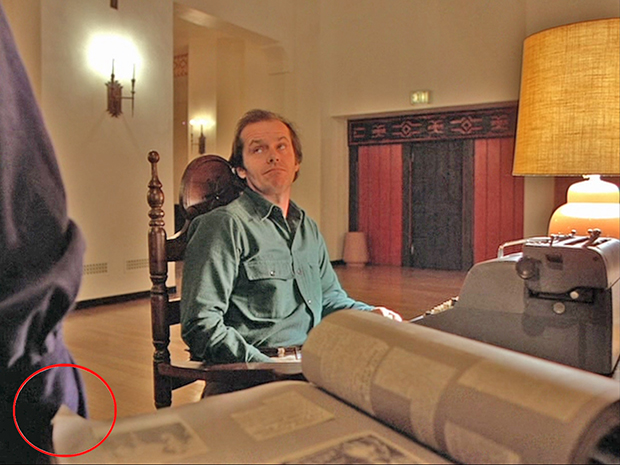
Fig. 52 - Shot 197. What the...?
When I try highlighting it, the corner is still rather confusing, except for the fact it is shown and wasn't shown before.
As for the shadow on it. I'm not positive it is a shadow and think it may be simply a different shade. One would suppose that the shadow is created by Wendy. She does cast a shadow on the book, but she moves very slightly and when she does you see the movement of her shadow higher on the page. This dark triangular area does not move, however, when she does. So that shadow on the corner of the page is not created by her.
I'm not even certain that this isn't a special effect, like the double knob on the ceiling in the Saturday section that appears to be a special effect, which we don't notice as our eyes are on the girls Danny has confronted.
Shot 199 is framed as 197 and we have the furnishings returned. The corner of the page is again gone.
If I may say so myself, that corner of the page looks pasted in. It's unnatural. It doesn't quite fit.
Such a little, simple detail upon which to find a person focusing their attention, the corner of a page that is absent when a chair and table are present, but when the chair and table are absent the corner of the page is there but in a kind of artificial shadow.
Look how perfectly the chair and table fit over the vents, concealing them.
Why do I fasten onto this detail as being possibly significant? How did Tuesday begin? Let's take another look. At the opening of this section, recollect, we see the mountain top and Wendy cutting over it with the can opener. You may understand why I look upon Wendy as cutting off the mountain top, which we will not see after this section. The storm is moving in and from now on when we view the lodge the mountain behind it will be entirely obscured from view by the storm. So, I've seen the can opener incident as a kind of metaphor of this. And I view the very simple but peculiar alteration of the corner of the page as being perhaps connected with this, as well as the manner in which the table and chair disappear and reappear.
There is a little more to it than what I am expressing at this point, but I'm hoping as we move along my thoughts on this will become clearer as we examine more examples of things disappearing, these occurances being connected in as much as they form a pattern, and have everything to do with Danny in the maze at the film's end and the manner in which he too disappears so that Jack is unable to find him.
Up to this point in The Shining, things had been going fairly well for Wendy and Danny and Jack at the Overlook, in as much as he hadn't entered his crisis yet, that state of obsession in which he types over and over again the one phrase, "All work and no play make Jack a dull boy." But that has now changed. The shift has been made. Whereas Bill in Eyes Wide Shut seems somewhat aware that something peculiar is happening in his world and is alert to it, dialoguing with it as best he can, Jack seems entirely unaware, becoming more and more enslaved to the lodge and less connected to his family, with whom he already had a fragile relationship.
As I've said before, the idea of the "overlook", of overlooking, also speaks to the viewer and their overlooking and missing a lot of the things that Kubrick is doing in his films. And I'm saying it again here.
In review, what has Kubrick given us in this section?
Room 237! We finally got to see Room 237. Or the outside of it. And that crazy carpet!
What's the teaser candy bait?
Who's going to notice teaser candy bait with that crazy carpet and finally getting to see Room 237, or the outside of it at least?
What's the distraction?
The carpet. And what the audience expects to see.
What's the Food for Thought?
Uh, wait a minute. Didn't the chair and table disappear behind Jack in the Colorado Lounge? That is the thing that is "off" that most will first notice in this section, for Kubrick puts it right in our line of sight very obviously.
What's the deep infrastructure?
The Fibonacci sequence and the golden ratio. Oh, and intentional sleight-of-hand misdirection. Except we noticed the chair and little table disappearing from before the vents! "Must be because it was a continuity error."
First placed online 2007-2009 in loose form. Added all shots 2012. Approx 12,300 words or 25 single-spaced pages. A 94 minute read at 130 wpm.
NEXT: THURSDAY
Return to Table of Contents for "The Shining" analysis
Link to the main TOC page for all the analyses


